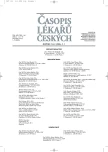Ten Years of Molecular Monitoring of Chronic Myeloid Leukemia by Quantitative RT-PCR
Deset let molekulárního monitorování chronické myeloidní leukémie metodou kvantitativní RT-PCR
Chronická myeloidní leukémie (CML) je charakterizována přítomností hybridního genu BCR-ABL, který vzniká v důsledku reciproké translokace t(9;22)(q34;q11) karyotypicky detekovatelné jako Ph chromozóm. Gen BCR-ABL kóduje hybridní protein s konstitutivně zvýšenou tyrozinkinázovou aktivitou, o kterém bylo prokázáno, že hraje zásadní roli v patogenezi onemocnění. Gen BCR-ABL je typickým znakem CML sloužícím k upřesnění diagnózy a sledování úspěšnosti léčby. Nejcitlivější metodou pro zjištění přítomnosti této aberace je reverzní transkriptázová polymerázová řetězová reakce (RT-PCR) detekující transkript BCR-ABL, se schopností zjistit 1 leukemickou buňku mezi 105–106 normálních leukocytů. Pro sledování změn v hladině transkriptů BCR-ABL je využívána kvantitativní RT-PCR (Q-RT-PCR), která má vysoký prognostický význam. Nárůst a vysoká hladina transkriptu BCR-ABL jednoznačně signalizují špatnou odpověď na léčbu a špatnou prognózu, naproti tomu pokles a nízká hladina BCR-ABL dobrou odpověď na léčbu a dobrou prognózu. Pomocí Q-RT-PCR je možno zjistit změny stavu onemocnění o několik týdnů i měsíců dříve než ostatními metodami. V ÚHKT v Praze byla Q-RT-PCR zavedena v roce 1994 pro potřebu časného zjištění relapsu u pacientů po transplantaci kmenových buněk (TKB) a nyní je využívána pro monitorování úspěšnosti léčby všech pacientů s CML. Potvrdili jsme, že tato citlivá, přesná a neinvazivní vyšetřovací metoda má pro sledování stavu pacientů s CML zásadní význam.
Klíčová slova:
CML, BCR-ABL, kvantitativní RT-PCR, stav onemocnění, prognóza onemocnění.
Authors:
J. Moravcová; R. Brdička
Authors‘ workplace:
Oddělení molekulární genetiky, Ústav hematologie a krevní transfuze, Praha
Published in:
Čas. Lék. čes. 2005; 144: 32-37
Category:
Review Article
Overview
Chronic myeloid leukemia (CML) is characterized by the presence of BCR-ABL fusion gene resulting from the reciprocal chromosome translocation t(9;22)(q34;q11), karyotypically detected as Ph chromosome. BCR-ABL gene was proved to play the principal role in CML pathogenesis. It is a hallmark of CML used in diagnostics and monitoring of the response to the therapy. The most sensitive method of detecting BCR-ABL aberration is RT-PCR which is able to find a single in leukemic cell betweey 106 normal leukocytes. Monitoring of BCR-ABL transcript level by quantitative RT-PCR is of the high prognostic value. High or increasing BCR-ABL transcript number signalizes bad response to treatment and a bad prognosis. On the contrary RT-PCR negativity, low level, or decreasing BCR-ABL transcript number denotes good response to treatment and good prognosis. Q-RT-PCR can detect changes in disease status several weeks or even months earlier than other methods. In 1994 the Q-RT-PCR was introduced at the Institute of Hematology and Blood Transfusion in Prague and was used for early detection of relapse after transplantation. At present it is used in all patients with CML for monitoring of response to the treatment. We have confirmed that this precise, sensitive and non-invasive method is of the principal importance for monitoring of disease status in CML patients.
Key words:
CML, BCR-ABL, quantitative RT-PCR, disease status, disease prognosis.
Labels
Addictology Allergology and clinical immunology Angiology Audiology Clinical biochemistry Dermatology & STDs Paediatric gastroenterology Paediatric surgery Paediatric cardiology Paediatric neurology Paediatric ENT Paediatric psychiatry Paediatric rheumatology Diabetology Pharmacy Vascular surgery Pain management Dental HygienistArticle was published in
Journal of Czech Physicians

- Metamizole at a Glance and in Practice – Effective Non-Opioid Analgesic for All Ages
- Metamizole vs. Tramadol in Postoperative Analgesia
- Metamizole in the Treatment of Acute Postoperative Pain
- Possibilities of Using Metamizole in the Treatment of Acute Primary Headaches
- Current Insights into the Antispasmodic and Analgesic Effects of Metamizole on the Gastrointestinal Tract
Most read in this issue
- Acute Oesophageal Necrosis
- Genetic Determinants of Osteoporosis
- DNA Microarrays – A Modern Method for Differential Gene Expression Analysis and its Significance for Cancer Diagnostics and Therapy
- Physical Exercise and Yoga in Prevention and Treatment of Addictive Diseases
